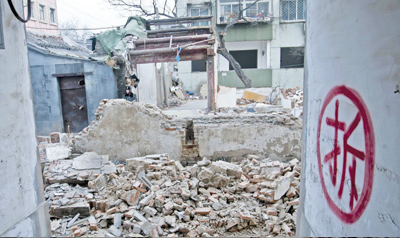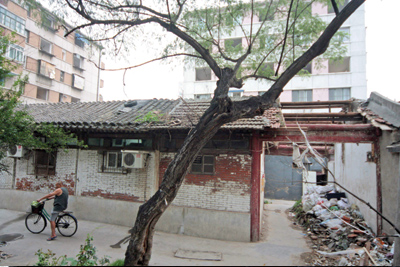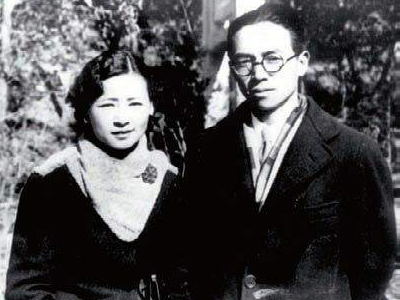A symbol of preservation
Updated: 2012-02-20 13:49
By Raymond Zhou (China Daily)
|
||||||||
 |
|
The former house of Liang Sicheng and Lin Huiyin in Dongcheng district of Beijing was demolished in January. Zhao Bing / For China Daily |
 |
|
A 2009 photo shows a part of the former residence. The demolition proceeded on and off till December 2011, when the house was listed by the State Administration of Cultural Heritage as an "immovable cultural relic". Wu Changqing / For China Daily |
 |
|
Liang and Lin in 1931 when the couple moved from Shenyang, Liaoning province, to Beijing. |
The leveling of an old-style house in Beijing that was the dwelling of a prominent couple of architects and preservationists has provoked a public outcry.
The demolition of the courtyard house he rented from 1931 to 1937 must have been the last thing Liang Sicheng worried about while he was alive. But for a nation that once sneered at his foresight and calls to protect heritage architecture, it is an ironic symbol for the inexorable advance of the bulldozer and the ravaging of everything that stands in its way.
Liang Sicheng (1901-72) and his wife Lin Huiyin (1904-55) were the most distinguished of modern Chinese architects. Among their creations are the national emblem of the People's Republic of China and the Monument to the People's Heroes on Tian'anmen Square. China's national award for architectural design is named after Liang.
The man who tried to save old Beijing

More important than that were his efforts, though failed, to protect the city walls of Beijing. In the early years of New China, Liang proposed to leave the old city intact and build a new one to its west. Later, as the city walls fell victim to political winds, he risked everything to save the walls first, then only the wall gates. The then Beijing mayor branded him "despotic" as they engaged in a tug of war over the fate of the old structures.
As they were torn down, Liang lamented: "Whenever a city gate was razed, it was as if they were slicing a piece of my flesh; whenever a section of the wall was gone, it was like skinning me."
We can't appreciate the void because very few of us have seen old Beijing in its authentic majesty, but we can probably understand Liang's frustration. He must have felt like the proverbial bug that tried to stop a rumbling carriage. Yes, he was crushed mercilessly. And we're all poorer for it.
"In 50 years, you'll know I'm right," Liang said famously. How prescient those words seem now.
In a sense, people today are trying to repeat on a very small scale the epic battle Liang attempted but tragically failed - and also to honor him in the process. Of all the residences he inhabited, the house at 24, Beizongbu Hutong, Dongcheng district of Beijing, stands out for two reasons: It was during the Liang couple's stay here that they studied and confirmed the dates and value of many historical works of architecture.
Sure, they conducted their scholarly research in the field, away from home. But while they were in Beijing, their residence served as a salon for the city's literati, attracting luminaries like novelist Shen Congwen and philosopher Jin Yuelin.
As Shan Jixiang, former director of the State Administration of Cultural Heritage, elucidates: "The emphasis should be placed on the transcendental, cultural and social values of an old residence, rather than purely on the architectural quality and artistic value."
Preserving Liang's old residence is tantamount to holding on to what he stands for: treasuring the tangible and immovable objects that were bequeathed to us by our ancestors and cement our cultural identity. We have made so many blunders before. Can't we save just this little piece of old Beijing?
Hutong in ruins
Large swaths of hutong (narrow lanes) and siheyuan (courtyard houses) have already given way to canyons of high rises. In the old days, when Chinese were barely skirting the poverty line, these old buildings, often rundown and crammed with a dozen or more households in a space designed for one, were perceived as eyesores. They do not have indoor plumbing, flush toilets or other modern amenities. People in the 1980s were eager to move out and into apartment buildings.
But the rapid rise of living standards and growing exposure to outside influences have awakened in us the intrinsic value of these uniquely Beijing residential forms. It did not take long before they crumbled in large expanses in the face of urban renewal.
Nationwide, the scene of destruction is multiplied hundreds of times as anything that obstructs the maximizing of profits is treated the same way so-called "class enemies" were dealt with in an earlier era.
If you talk to real estate developers and those who share their interests, you'll hear something different: These old buildings are invariably in ramshackle conditions, violating fire codes and otherwise not up to modern standards of safety or comfort. But they conveniently omit the fact these buildings tend to occupy large tracts of prime land, and their existence in the current mode will block the developers from realizing the highest profits from the land.
These people will be quick to add that they love traditional Chinese architecture more than anyone. As a matter of fact, they will rebuild this or that structure exactly as it looked in its most glorious days, but with reinforced beams and concrete pillars covered with wooden panels. In other words, they want the best of a theme park and a museum: seemingly ancient buildings with all the trappings of modernity.
That said, not all the "fake antique structures" are monstrosities. Some are tastefully designed and do not claim to have historical significance.
Where the famous once dwelt
The same contradiction manifests itself in some people's attitudes toward residences of the famed. On the one hand, the drive to raze old buildings rarely spare those surrounded by the luster of the distinguished residents, on the other hand there is an urge to associate a place with the big names of yore. In recent years, some local governments have ventured so far as to fight for the "official hometown" of fictional characters that surface only in novels or fairy tales.
One village I visited in 2011 constructed a new house it claimed to be the ancestral residence of an ancient general, in order to "enhance our cultural gravitas", to quote the village chief. But to his chagrin, he later found out another village in a nearby province had already claimed the same general to be their "native son".
What is the appropriate level of protection for old residences with historical value? Do we have to turn every one of them into a mini-museum? The cultural heritage bureaus can designate these buildings, but they usually do not provide the financial wherewithal for upkeep or protection. That is why local governments often take the side of developers.
Indeed, a few of these buildings can be turned into tourist destinations, but most do not have that potential. For those with low historical value and low tourism promise, some kind of middle ground should be found between indiscriminate demolition and strict protection. In this heyday of economic growth, it is unfeasible to expect the ubiquitous stipulation of "maintain it as it is" to counter the visual blaring of "chai!" (tear down).
Maybe some buildings should be allowed indoor renewal while keeping the facade. Others can leave the ground floor for public viewing with private spaces reserved for current owners.
One thing that can be done without too much cost or hassle - but with thorough research - is to place small plaques on those buildings once resided in by prominent citizens of the country or city. Just the name, the profession and the dates of stay will suffice.
Imagine how much a casual passerby will feel walking down the street with such "annotated" buildings. It'll be like walking down a history book.
Getting back to Liang Sicheng, who was the uncle of Maya Lin and the son of the great Liang Qichao. The public gets emotional about his home partly because most people who are not part of the intelligentsia learned about him and his love story through a wildly popular television soap opera.
Suddenly this pioneer of Chinese architecture and its preservation was humanized. You see history condensed in and refracted through one renowned family. That adds to the intangible value of his erstwhile abode. If only the people in charge of developing that property knew what an added asset that is.

 'Taken 2' grabs movie box office crown
'Taken 2' grabs movie box office crown
 Rihanna's 'Diamonds' tops UK pop chart
Rihanna's 'Diamonds' tops UK pop chart
 Fans get look at vintage Rolling Stones
Fans get look at vintage Rolling Stones
 Celebrities attend Power of Women event
Celebrities attend Power of Women event
 Ang Lee breaks 'every rule' to make unlikely new Life of Pi film
Ang Lee breaks 'every rule' to make unlikely new Life of Pi film
 Rihanna almost thrown out of nightclub
Rihanna almost thrown out of nightclub
 'Dark Knight' wins weekend box office
'Dark Knight' wins weekend box office
 'Total Recall' stars gather in Beverly Hills
'Total Recall' stars gather in Beverly Hills
Most Viewed
Editor's Picks

|

|

|

|

|

|
Today's Top News
Health new priority for quake zone
Xi meets US top military officer
Japan's boats driven out of Diaoyu
China mulls online shopping legislation
Bird flu death toll rises to 22
Putin appoints new ambassador to China
Japanese ships blocked from Diaoyu Islands
Inspired by Guan, more Chinese pick up golf
US Weekly

|

|






